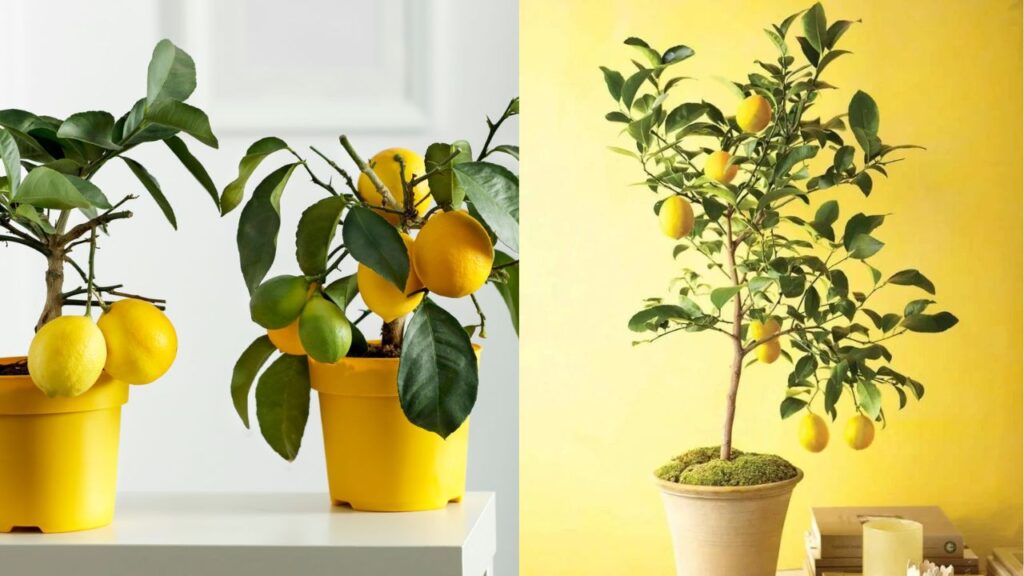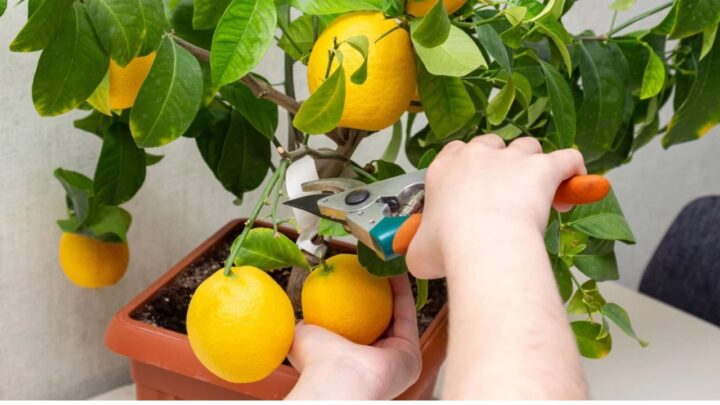Grow a Lemon Tree Indoors – Dreaming of plucking fresh lemons from your living room? With the right care and setup, you can actually grow a healthy, fruit-bearing lemon tree inside your home. Here’s the secret method that ensures your indoor lemon tree not only survives but thrives with juicy, aromatic fruits.

Understanding Indoor Lemon Tree Basics
Growing lemons indoors isn’t as hard as it seems. All you need is the right balance of sunlight, humidity, and nutrients. Lemon trees, especially dwarf varieties like ‘Meyer Lemon’, are ideal for small spaces and can flourish year-round if treated right.
A strong indoor lemon tree requires 6–8 hours of sunlight each day, a well-draining pot, and consistent care. Keep it near a bright window or under grow lights to mimic outdoor conditions.
Choosing the Best Lemon Variety for Indoors
Not all lemon types are suitable for indoor environments. Some grow too tall or require specific climates. The easiest options are compact, self-pollinating varieties that adapt to indoor conditions.
- Meyer Lemon: Sweet flavor and compact size.
- Ponderosa Lemon: Large fruit, excellent aroma.
- Eureka Lemon: Classic store-bought taste.
- Lisbon Lemon: Vigorous grower with rich flavor.
Choose a healthy, grafted plant from a nursery for faster fruiting results.
Step-by-Step Guide to Grow a Lemon Tree Indoors
- Step 1: Pick the Right Container
Use a large pot (at least 12–14 inches deep) with good drainage holes. Lemon trees dislike soggy roots, so avoid waterlogging. Clay or terracotta pots are best because they allow air circulation and prevent root rot.

- Step 2: Use the Perfect Soil Mix
Lemons need slightly acidic, well-draining soil. Mix potting soil with sand, perlite, and a bit of compost. You can also buy a citrus-specific potting mix to ensure your tree gets the right nutrients.
- Step 3: Ensure Proper Sunlight
Place your lemon tree near a south-facing window where it can soak up full sunlight for most of the day. If natural light is limited, use a full-spectrum grow light for 10–12 hours daily to promote flowering and fruiting.
- Step 4: Maintain Ideal Watering Schedule
Water your tree deeply but infrequently. The soil should stay moist, not wet. Check by touching the top 2 inches—if dry, it’s time to water. Always empty the saucer after watering to prevent standing water.
- Step 5: Feed with Citrus Fertilizer
Fertilize your lemon tree every 3–4 weeks during spring and summer. Use a balanced, citrus-specific fertilizer rich in nitrogen and magnesium. This keeps the leaves dark green and encourages blooming.
- Step 6: Encourage Pollination Indoors
Lemon trees need pollination to produce fruit. Indoors, this can be done manually using a small brush or cotton swab. Gently transfer pollen from one flower to another to mimic bees’ natural work.

Extra Tips for a Healthy Indoor Lemon Tree
- Rotate the pot weekly to ensure even sunlight exposure.
- Maintain indoor humidity between 40–60% for better leaf health.
- Prune dead or overcrowded branches to promote air circulation.
- Wipe leaves gently with a damp cloth to remove dust and pests.
- Move your lemon tree outdoors during summer for natural sunlight.
FAQs
How long does it take for an indoor lemon tree to fruit?
Most indoor lemon trees begin fruiting within 2–3 years if given proper care, sunlight, and nutrients. Grafted trees usually fruit faster than seed-grown ones.
Can a lemon tree survive only under artificial light?
Yes, as long as it receives 10–12 hours of high-quality grow light daily. Full-spectrum LED grow lights are perfect for indoor citrus growth.
Why are my lemon tree leaves turning yellow?
Yellow leaves often indicate overwatering, poor drainage, or lack of nutrients. Allow the soil to dry slightly between waterings and apply a balanced citrus fertilizer.
Do I need to prune my indoor lemon tree regularly?
Yes, pruning helps control size, remove weak branches, and encourage more blooms. Trim lightly after each fruiting cycle for healthy regrowth.
 Transform Plastic Bottles Into a Tower Garden – 3-Story Strawberry DIY Every Home Grower Must Try
Transform Plastic Bottles Into a Tower Garden – 3-Story Strawberry DIY Every Home Grower Must Try
Growing your own lemon tree indoors is both rewarding and refreshing. Imagine sipping fresh lemonade made from fruits grown right inside your home! With patience, sunlight, and love, your tree will flourish and fill your space with a delightful citrus fragrance and beautiful yellow fruits.



